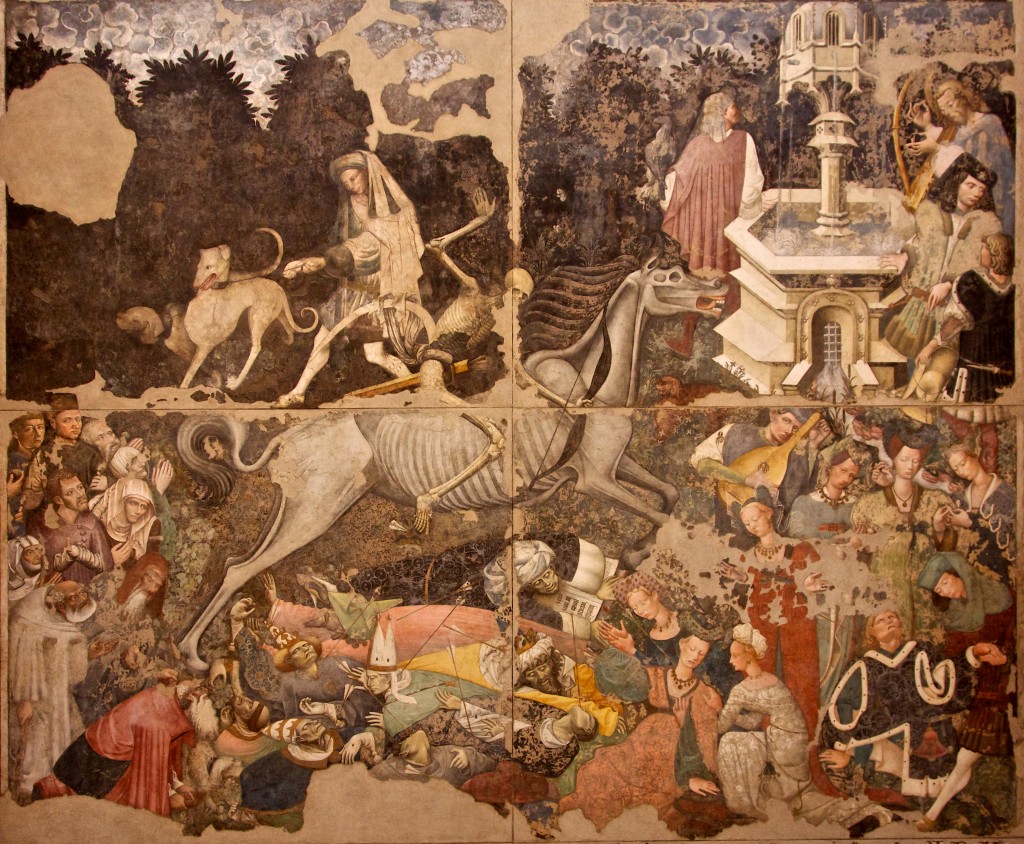
By Patrick Hunt
Plague in the Middle Ages was a constant specter of death for much of the population for centuries, especially in the Mediterranean where ports were the point of entry for plagues in many kingdoms. Sicily was no exception, in fact it was one of the first places where the pandemic bubonic “Black Death” of 1347-51 reached due to its vital port cities like Messina and Palermo connected to Eastern luxury trade items like silk and spices, possibly killing 50% or more of urban population – “an overall high death rate”,[1] especially in those seaports Messina and Palermo. [2] Many cemeteries have survived for plague-era victims, with enough dental remains for analysis of likely plague victims from the logical culprit bacterium Yrsenia pestis, although not all have always agreed this was the plague agent. [3] Paleopathology confirms the ubiquity of death from plague was pervasive across Europe, such that the theme of the Triumph of Death (Trionfo Nella Morte in Italian) was so well recognized in art that often no words or text were needed to accompany paintings or frescoes, as seen here in this anonymous work dated from around the 1440’s. Nascent etiology of the origins and symptoms of bubonic plague can even be seen in this fascinating fresco now in the Palazzo Abatellis of Palermo, the regional medieval museum.
Measuring 5.9 x 6.4 meters in its dimensions, the painting of the Triumph of Death has been partly damaged in places from where it was originally placed in the Sclafani Palace, which had been rebuilt and transformed by the Aragonese king Alfonso into the ‘New Hospital’ that was itself later turned into barracks. [4] The wall painting was divided into four parts for removal from the Palazzo Sclafani and its quartered edges show signs of wear.
Although the debate over whether the so-called “Black Death” was in fact bubonic plague – such as described by Procopius half a millennium earlier around 540 CE in his histories with details of buboes [5] – has been intense, several clues in this painting provide evidence that the plague represented here was bubonic plague. The transmission of bubonic plague, the culprit now firmly identified as the bacterium Yrsenia pestis, required several vectors including the ship-borne rat (Rattus rattus) and its fleas (Siphonaptera ssp.) in whose intestines the bacterium Yrsenia pestis multiplied. The source of the great particular plague between 1347-51 CE has been long established to derive from Central Asia with the Golden Horde in 1346, moving first into Constantinople before traveling across the Mediterranean in maritime traffic.
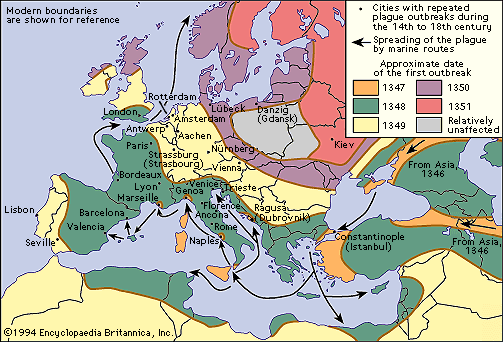
While no attribution to an artist has been found for this anonymous work, several possible likelihoods have been raised for the artist, generally named the Master of the Triumph of Death (Maestro del Trionfo della Morte), including the more well known Antonio Pisanello (c. 1395-1455) of Pisa and Rome and the lesser known Gaspare Pesaro (c. 1400-61) of Sicily, both of whom did work for Alfonso of Aragon somewhere after 1440 when the ‘New Hospital’ was founded. [6]
This large wall-sized painting of the Triumph of Death can be divided into roughly six parts in its overall context of a large garden surrounded by a hedge. In the center (fig. 1) a skeletal Death himself invades, riding a pale, emaciated and skeletal horse whose ribs show. Death with shreds of skin hanging off his ankle bones and a few other places – shoots arrows from a bow and also carries a mostly invisible scythe (its curved blade has snagged on the lower clothes of the man in central upper left). Nearly all of Death’s victims, past, recent or present, bear arrows sticking out of their bodies. At central upper left (fig. 1) is a man walking several dogs on taut leashes, the one on the left may be best described as a bloodhound and the dog on the right appears to be growling and barking at what has just ridden by (Death), appearing to be a hunting mastiff. As mentioned, Death’s scythe has just hooked the man’s clothes and one of his dogs may be aware based on its keen sense of smell? – that its master is about to be mowed down. At lower left (fig. 3) is a mysterious group. Some interpretations posit that this group is imploring Death to end their suffering, but the hypothesis suggested instead here in this article is that they are plague survivors: Death has ridden by and they have been left apparently visually unscathed with no arrows protruding from them. It is possible that plague completely swept by them for whatever reasons. Several of these possible “survivors” will be detailed shortly. Below the horse at lower center (fig. 3) is a group of Death’s victims, all clearly dead and grey in pallor. The range of people from all walks of life and from every level of wealth and their inability to be protected against plague death is striking here. This powerful group mostly comprises brocaded kings, popes, cardinals, prelates, priests and possibly even a Moslem if based on his turban.[7] Crowns, mitres, and even tonsured heads make it clear that earthly power or a clerical life are not enough to save from Death’s clutches because their collective flesh hue is all grey in death. At upper right a group of musicians and a falconer gather around a spraying fountain. On one hand they seem oblivious of Death’s moving toward them but on the other hand if they understood its health perhaps the fountain might represent the hygienic nature of sanitation and clean, running water? At the bottom right of the painting in the advancing path of relentless Death is a group of richly dressed nobles – seven women and three men – with the rich flesh tones of the living. Arrows have just struck a few of these young nobles and others are only becoming aware of danger as they look to the left or at the arrows having immediately landed. One member of this last group of ten is a musician holding a theorbo or lute as he looks apprehensive, almost cowering at the approach of Death.
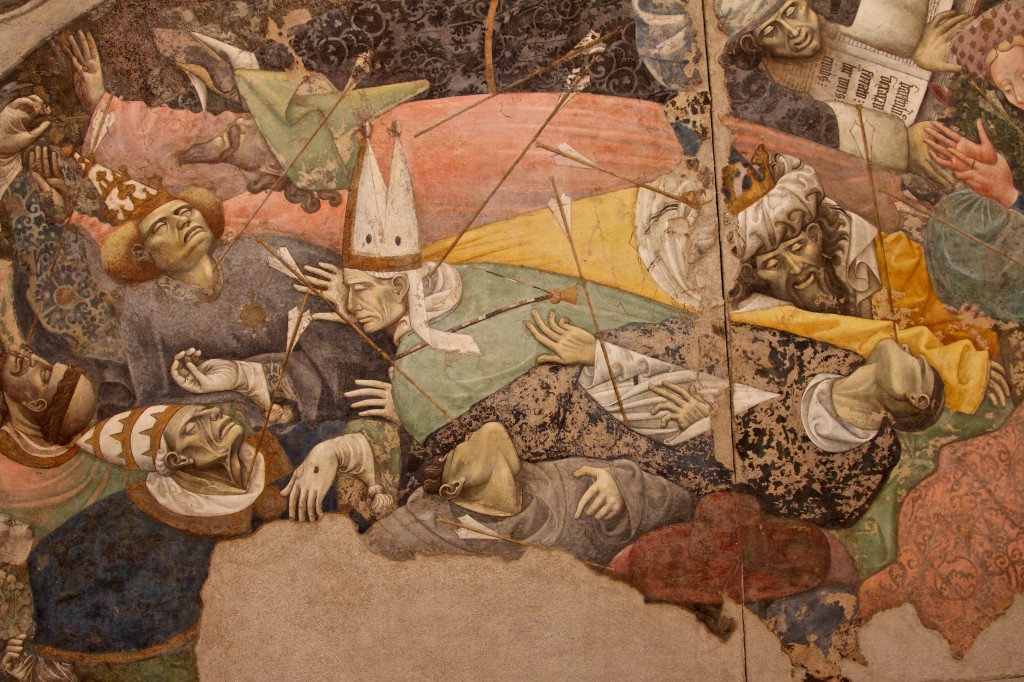
Since the ‘Triumph of Death’ painting is at least a full generation later than Giovanni Boccaccio’s Decameron, whose literary context is a group of Florentine nobility who have fled Florence to the country for their ten-day sojourn to escape the scale of urban death as a frame for the stories related, this painting may even be a depiction meant to illustrate or reference the Decameron, especially given the circle of seven young noble women and three young men at the right of the painting as framed in Boccaccio’s collection of tales: recounted in ten days by an honorable company of seven ladies and three young men in the time of the late mortal pestilence. [8] Boccaccio (1313-75) lived through the Black Death of 1347-51 and was also highly aware of Palermitan wealth and power as he describes its prestigious trade in silk and pearl-laden citizens in his tales, most of whom like the citizens of Florence would be mowed down by plague if they were unable to escape in time to the healthier countryside. Although their lives did not overlap, both Pisanello and the earlier Boccaccio spent considerable time in Florence and while Boccaccio traveled to Palermo, Pisanello also had high favor in the court of Alfonso of Aragon, King of the Two Sicilies who governed from Naples and Palermo. Pisanello appears to have spent the rest of his life after 1448 in Naples and Palermo.
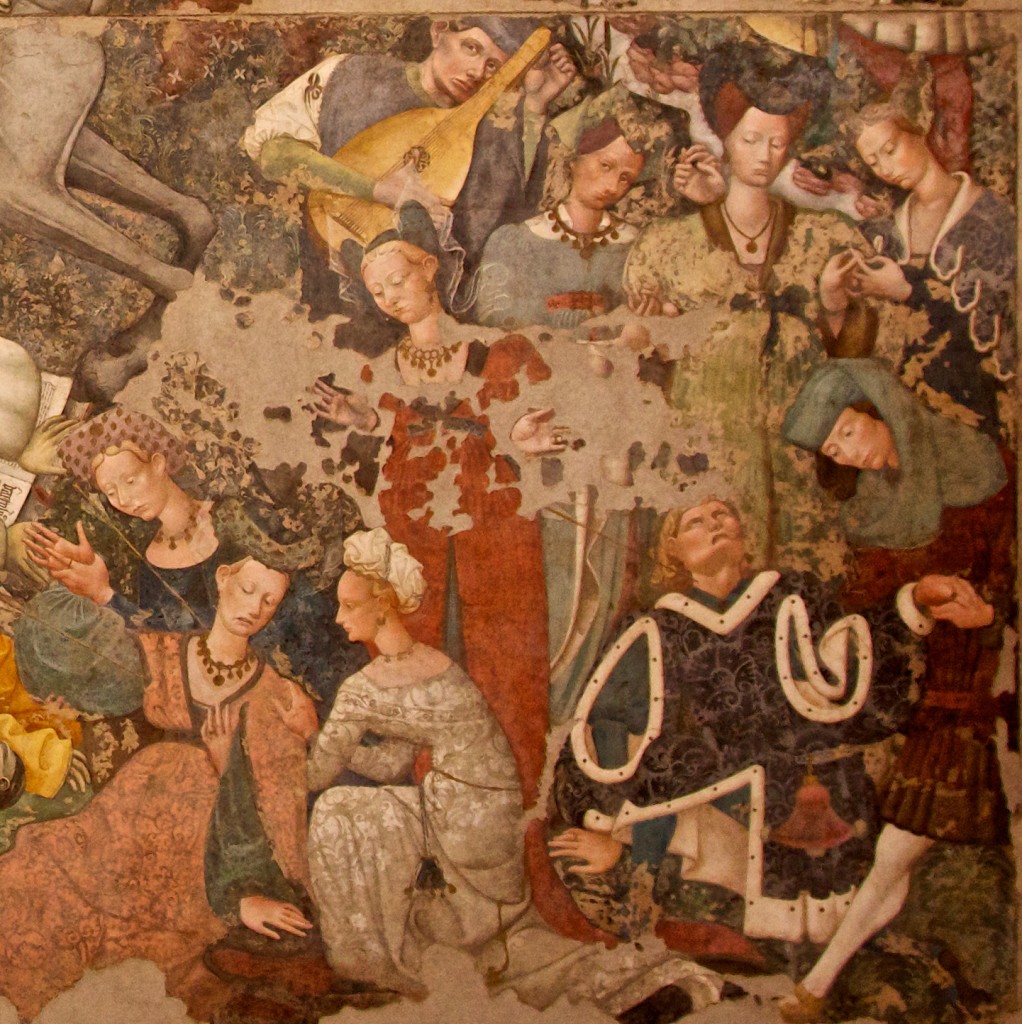
Some important observations from details of the painting deserve mention in increasing relevance. First, as mentioned, in the living group of possible ˜survivors” behind Death (figs. 6 & 7), the anonymous artist has most likely painted himself looking out directly at the viewer while holding a brush; left of him is his likely assistant or apprentice also looking out. Second, in the plague group on the bottom right (fig. 5), one elegantly dressed woman grimaces in a rictus of shock and fear at the arrow just having struck her while her companion on the right (further from Death’s advance) may be attempting to comfort her. Third, nearly all of Death’s arrows are protruding from the necks of the victims, which greatly favors the responsive lymphatic nature of bubonic plague where the body attempts – too often in futility (~50% mortality at the time) – to fight off the assault on the immune system. Fourth, a close look at Death’s bow shows it to be a compound bow from the East, likewise his arrow sheath, suggesting a cognition that this form of death came from the Mongol Empire, commensurate with the plague of 1347-51 arriving with the Golden Horde from Central Asia where the Mongol Empire was already then mostly on the wane.[9]
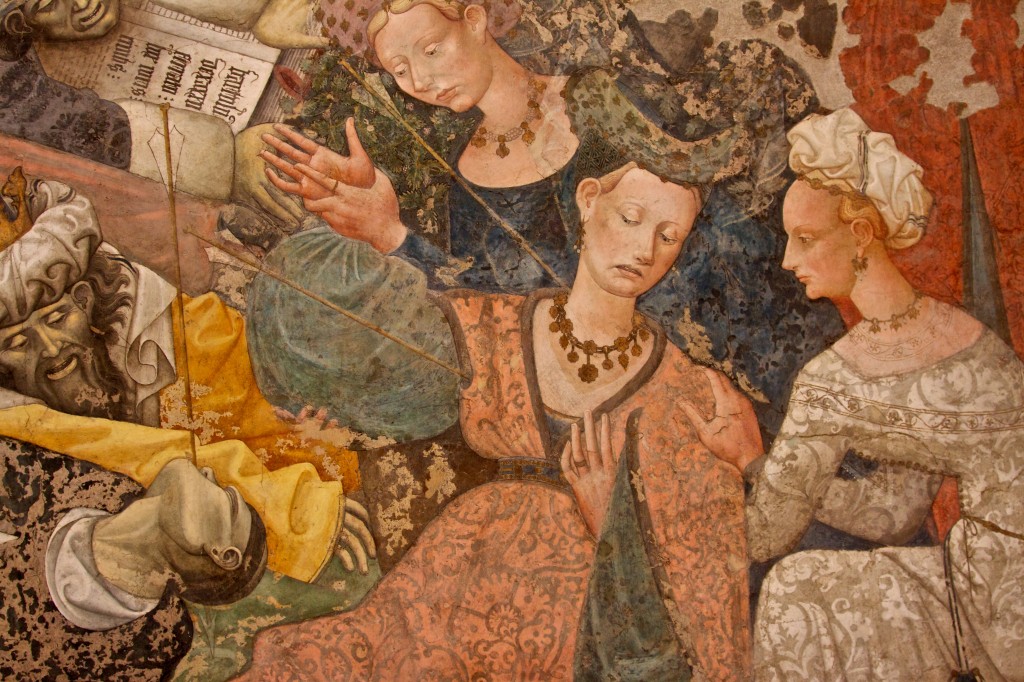
Fifth, because Death has passed by them already, the group on the lower left may represent what I have suggested are ˜survivors” (including the artists at top), among them several monk hermits at bottom, the latter possibly surviving due to their remoteness from the congestion and unsanitary conditions of urban life; their isolation and low population density is the opposite of the wealthy and powerful court and cathedral rulers.
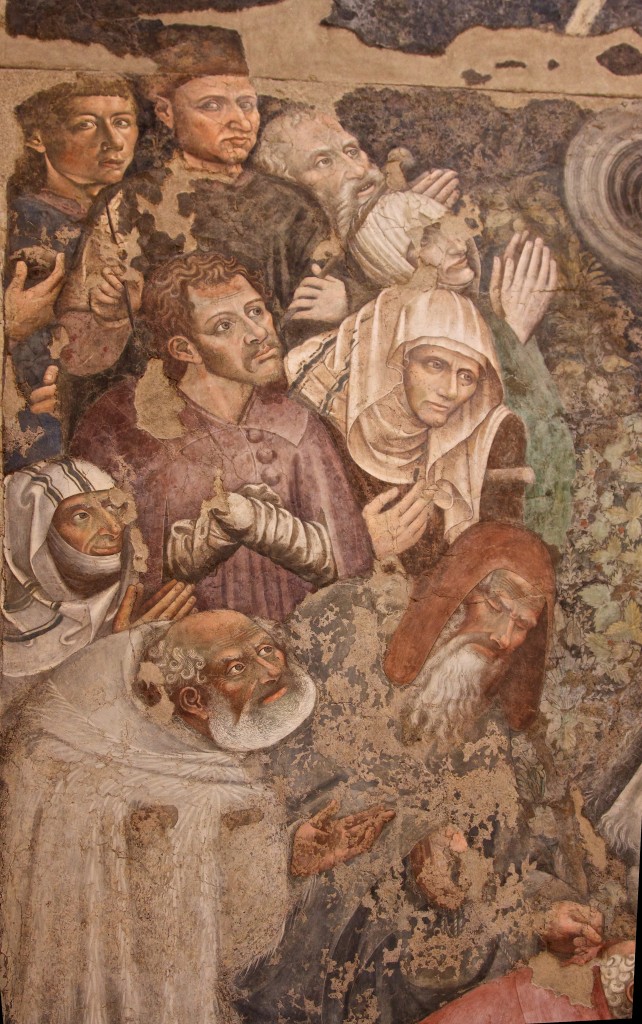
Sixth and last, several of the women whom I have termed “survivors” on the painting’s lower left – especially the two women on the far left – appear to be wearing what may be a Jewish prayer shawl (tallit) with its white color and a few blue bands on its margins. If ‘survivors’ of bubonic plague, did they survive because they were faithful to Levitical law (summarized in Leviticus 13), which mandates repeated examination, isolation and quarantine, burning of infect material, kosher lifestyle and other Jewish sanitary habits? It was not infrequent that Jews were blamed and even burned alive for plague because the toll of death was usually far lower in their dense ghettoes. The man in purple between the two ladies is a mystery: is he a leper (note his wrapped hands – are they missing digits?). If he is a leper, he could have survived because lepers were usually cast out and often greatly isolated from the rest of the population. Urban lepers would not have survived if their immune systems and lungs were already compromised by another Mycobacterium disease: leprosy is Mycobacterium leprae and tuberculosis is Mycobacterium tuberculosis and the two diseases were often tandem infections in the same living human.[10] Or could this man in purple – a conundrum in the painting – between the two ladies possibly wearing Jewish prayer shawls be a Jewish doctor with hands wrapped to protect himself from contracting the disease? Again, the Torah text of Leviticus 13 is very explicit about quarantine and sanitation, which ideas were relatively undocumented in Western medicine until Ignaz Semmelweis and puerperal fever in 1837 in Vienna and Budapest yet unheeded until Louis Pasteur in the 1870’s.[11] It should not be overlooked that the original context of this painting was in Alfonso’s ‘New Hospital’ (Palazzo Sclafani) circa 1448, which would make its plague subject matter all the more instructive.
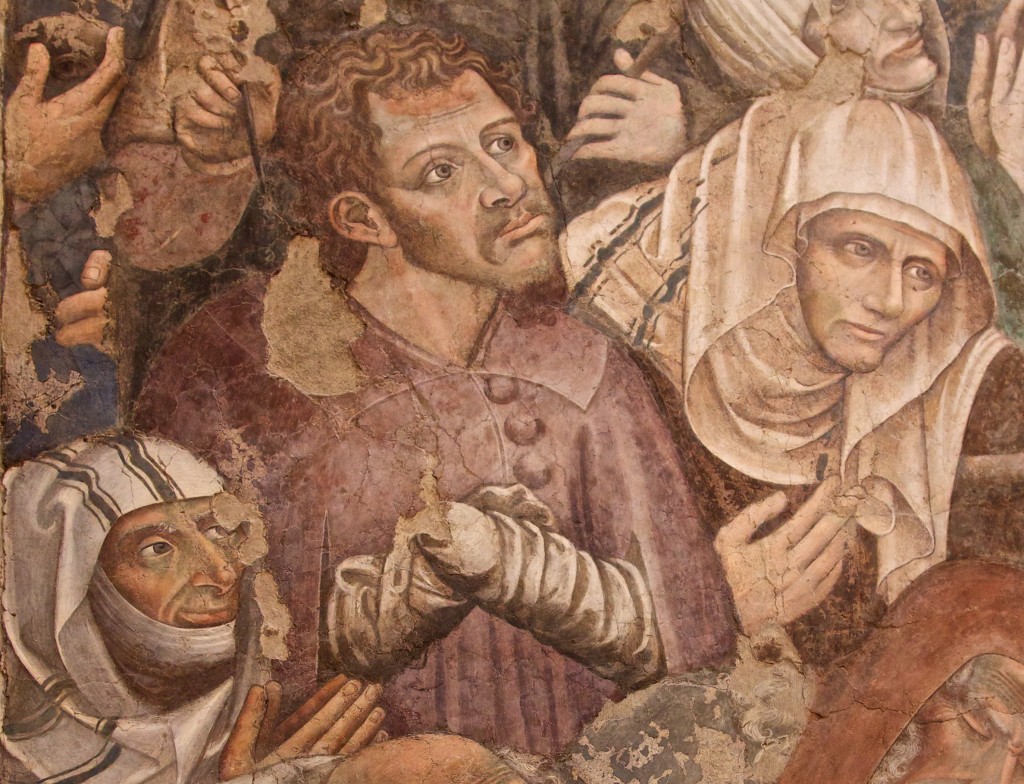
In summary, this Palermitan painting shows a high awareness in its portrayal of some of the near-ubiquitous plague conditions and consequences in this exceptionally poignant work of art that may directly reference to the mid-14th c. with Black Death prevalent 1347-51 as well as allude the context of Boccaccio’s Decameron. Regardless, the work of art is a startling visual document of the 15th century Triumph of Death with some recognition by medieval artists of plague etiology, remarkable for late medieval medicine.
Notes:
The author of this article has seen this painting at least a dozen times in as many years (most recently in April 2012), having also lectured on it multiple times.
[1] Jesper Boldsen and George Milner, “An Epidemiological Approach to Paleopathology” in Anne L. Grauer, ed. A Companion to Paleopathology. Wiley-Blackwell, 2011, 123.
[2] Arthur Auderheide and Conrado Rodriguez-Martin. “Plague (Peste, Black Death).” The Cambridge Encyclopedia of Paleopathology. Cambridge: Cambridge University Press, 1998, 197; Philip Daileader, True Citizens: Violence, Memory, and Identity in the Medieval Community of Perpignan, 1162-1397, Leiden: E.J. Brill, 2000.
[3] Alicia K. Wilbur and Anne C. Stone,”Using Ancient DNA Techniques to Study Human Disease” in Jane Buikstra and Charlotte Roberts, eds. The Global History of Paleopathology: Pioneers and Prospects. Oxford University Press, 2012, 705.
[4] Ingrid Valser. The Theme of Death in Italian Art: The Triumph of Death. M.A. Thesis, McGill University, 96.
[5] Procopius, History of the Vandal Wars, III.xiv.5-10
[6] Volser, 97-98. Pisanello was also professionally known as Antonio di Puccio Pisano or Antonio di Puccio da Cereto.
[7] This dead victim of plague may be literate, since he holds a document. One word of this document may read peccatu[m] as “sin” or errata both in Latin, but this is speculative. Due to the high number of clerics in the painting, who may have preached the cause of plague as sin, this perception would also be clearly in error as medieval observers who saw they were just as vulnerable; as in much later Existentialist literature like Camus’ The Plague, their religious lives did not protect them.
[8] Boccaccio, Decameron, Proem. xiii
[9] ibid., Decameron, First Day, Introduction, 8
[10] Buikstra and Roberts, 58
[11] Helmut Wyklicky and Manfred Skopec. “Ignaz Phiipp Semmelweis: The Prophet of Bacteriology.” Proceedings of the First International Symposium on Hospital-Acquired Infections. Journal of Infection Control 4.5 (1983) 367-70.